Yushi Bai
Shifting Long-Context LLMs Research from Input to Output
Mar 07, 2025Abstract:Recent advancements in long-context Large Language Models (LLMs) have primarily concentrated on processing extended input contexts, resulting in significant strides in long-context comprehension. However, the equally critical aspect of generating long-form outputs has received comparatively less attention. This paper advocates for a paradigm shift in NLP research toward addressing the challenges of long-output generation. Tasks such as novel writing, long-term planning, and complex reasoning require models to understand extensive contexts and produce coherent, contextually rich, and logically consistent extended text. These demands highlight a critical gap in current LLM capabilities. We underscore the importance of this under-explored domain and call for focused efforts to develop foundational LLMs tailored for generating high-quality, long-form outputs, which hold immense potential for real-world applications.
LongWriter-V: Enabling Ultra-Long and High-Fidelity Generation in Vision-Language Models
Feb 20, 2025Abstract:Existing Large Vision-Language Models (LVLMs) can process inputs with context lengths up to 128k visual and text tokens, yet they struggle to generate coherent outputs beyond 1,000 words. We find that the primary limitation is the absence of long output examples during supervised fine-tuning (SFT). To tackle this issue, we introduce LongWriter-V-22k, a SFT dataset comprising 22,158 examples, each with multiple input images, an instruction, and corresponding outputs ranging from 0 to 10,000 words. Moreover, to achieve long outputs that maintain high-fidelity to the input images, we employ Direct Preference Optimization (DPO) to the SFT model. Given the high cost of collecting human feedback for lengthy outputs (e.g., 3,000 words), we propose IterDPO, which breaks long outputs into segments and uses iterative corrections to form preference pairs with the original outputs. Additionally, we develop MMLongBench-Write, a benchmark featuring six tasks to evaluate the long-generation capabilities of VLMs. Our 7B parameter model, trained with LongWriter-V-22k and IterDPO, achieves impressive performance on this benchmark, outperforming larger proprietary models like GPT-4o. Code and data: https://github.com/THU-KEG/LongWriter-V
LongBench v2: Towards Deeper Understanding and Reasoning on Realistic Long-context Multitasks
Dec 19, 2024



Abstract:This paper introduces LongBench v2, a benchmark designed to assess the ability of LLMs to handle long-context problems requiring deep understanding and reasoning across real-world multitasks. LongBench v2 consists of 503 challenging multiple-choice questions, with contexts ranging from 8k to 2M words, across six major task categories: single-document QA, multi-document QA, long in-context learning, long-dialogue history understanding, code repository understanding, and long structured data understanding. To ensure the breadth and the practicality, we collect data from nearly 100 highly educated individuals with diverse professional backgrounds. We employ both automated and manual review processes to maintain high quality and difficulty, resulting in human experts achieving only 53.7% accuracy under a 15-minute time constraint. Our evaluation reveals that the best-performing model, when directly answers the questions, achieves only 50.1% accuracy. In contrast, the o1-preview model, which includes longer reasoning, achieves 57.7%, surpassing the human baseline by 4%. These results highlight the importance of enhanced reasoning ability and scaling inference-time compute to tackle the long-context challenges in LongBench v2. The project is available at https://longbench2.github.io.
AlphaTablets: A Generic Plane Representation for 3D Planar Reconstruction from Monocular Videos
Nov 29, 2024



Abstract:We introduce AlphaTablets, a novel and generic representation of 3D planes that features continuous 3D surface and precise boundary delineation. By representing 3D planes as rectangles with alpha channels, AlphaTablets combine the advantages of current 2D and 3D plane representations, enabling accurate, consistent and flexible modeling of 3D planes. We derive differentiable rasterization on top of AlphaTablets to efficiently render 3D planes into images, and propose a novel bottom-up pipeline for 3D planar reconstruction from monocular videos. Starting with 2D superpixels and geometric cues from pre-trained models, we initialize 3D planes as AlphaTablets and optimize them via differentiable rendering. An effective merging scheme is introduced to facilitate the growth and refinement of AlphaTablets. Through iterative optimization and merging, we reconstruct complete and accurate 3D planes with solid surfaces and clear boundaries. Extensive experiments on the ScanNet dataset demonstrate state-of-the-art performance in 3D planar reconstruction, underscoring the great potential of AlphaTablets as a generic 3D plane representation for various applications. Project page is available at: https://hyzcluster.github.io/alphatablets
Pre-training Distillation for Large Language Models: A Design Space Exploration
Oct 21, 2024



Abstract:Knowledge distillation (KD) aims to transfer knowledge from a large teacher model to a smaller student model. Previous work applying KD in the field of large language models (LLMs) typically focused on the post-training phase, where the student LLM learns directly from instructions and corresponding responses generated by the teacher model. In this paper, we extend KD to the pre-training phase of LLMs, named pre-training distillation (PD). We first conduct a preliminary experiment using GLM-4-9B as the teacher LLM to distill a 1.9B parameter student LLM, validating the effectiveness of PD. Considering the key impact factors of distillation, we systematically explore the design space of pre-training distillation across four aspects: logits processing, loss selection, scaling law, and offline or online logits. We conduct extensive experiments to explore the design space of pre-training distillation and find better configurations and interesting conclusions, such as larger student LLMs generally benefiting more from pre-training distillation, while a larger teacher LLM does not necessarily guarantee better results. We hope our exploration of the design space will inform future practices in pre-training distillation.
LongCite: Enabling LLMs to Generate Fine-grained Citations in Long-context QA
Sep 04, 2024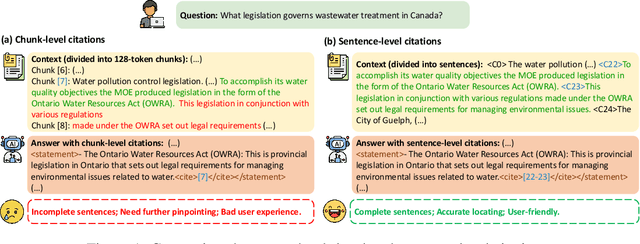


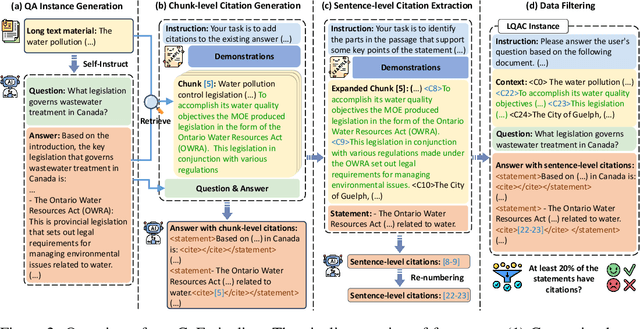
Abstract:Though current long-context large language models (LLMs) have demonstrated impressive capacities in answering user questions based on extensive text, the lack of citations in their responses makes user verification difficult, leading to concerns about their trustworthiness due to their potential hallucinations. In this work, we aim to enable long-context LLMs to generate responses with fine-grained sentence-level citations, improving their faithfulness and verifiability. We first introduce LongBench-Cite, an automated benchmark for assessing current LLMs' performance in Long-Context Question Answering with Citations (LQAC), revealing considerable room for improvement. To this end, we propose CoF (Coarse to Fine), a novel pipeline that utilizes off-the-shelf LLMs to automatically generate long-context QA instances with precise sentence-level citations, and leverage this pipeline to construct LongCite-45k, a large-scale SFT dataset for LQAC. Finally, we train LongCite-8B and LongCite-9B using the LongCite-45k dataset, successfully enabling their generation of accurate responses and fine-grained sentence-level citations in a single output. The evaluation results on LongBench-Cite show that our trained models achieve state-of-the-art citation quality, surpassing advanced proprietary models including GPT-4o.
LongWriter: Unleashing 10,000+ Word Generation from Long Context LLMs
Aug 13, 2024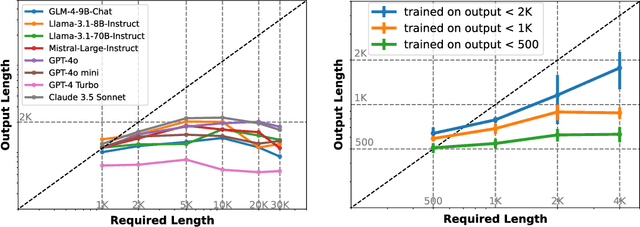


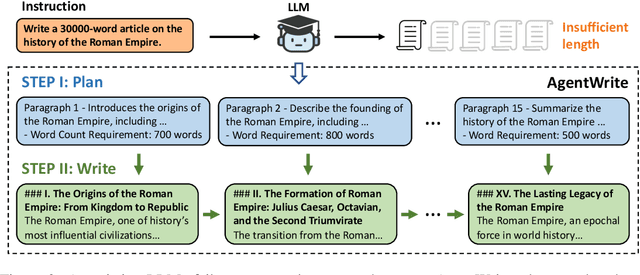
Abstract:Current long context large language models (LLMs) can process inputs up to 100,000 tokens, yet struggle to generate outputs exceeding even a modest length of 2,000 words. Through controlled experiments, we find that the model's effective generation length is inherently bounded by the sample it has seen during supervised fine-tuning (SFT). In other words, their output limitation is due to the scarcity of long-output examples in existing SFT datasets. To address this, we introduce AgentWrite, an agent-based pipeline that decomposes ultra-long generation tasks into subtasks, enabling off-the-shelf LLMs to generate coherent outputs exceeding 20,000 words. Leveraging AgentWrite, we construct LongWriter-6k, a dataset containing 6,000 SFT data with output lengths ranging from 2k to 32k words. By incorporating this dataset into model training, we successfully scale the output length of existing models to over 10,000 words while maintaining output quality. We also develop LongBench-Write, a comprehensive benchmark for evaluating ultra-long generation capabilities. Our 9B parameter model, further improved through DPO, achieves state-of-the-art performance on this benchmark, surpassing even much larger proprietary models. In general, our work demonstrates that existing long context LLM already possesses the potential for a larger output window--all you need is data with extended output during model alignment to unlock this capability. Our code & models are at: https://github.com/THUDM/LongWriter.
Finding Safety Neurons in Large Language Models
Jun 20, 2024Abstract:Large language models (LLMs) excel in various capabilities but also pose safety risks such as generating harmful content and misinformation, even after safety alignment. In this paper, we explore the inner mechanisms of safety alignment from the perspective of mechanistic interpretability, focusing on identifying and analyzing safety neurons within LLMs that are responsible for safety behaviors. We propose generation-time activation contrasting to locate these neurons and dynamic activation patching to evaluate their causal effects. Experiments on multiple recent LLMs show that: (1) Safety neurons are sparse and effective. We can restore $90$% safety performance with intervention only on about $5$% of all the neurons. (2) Safety neurons encode transferrable mechanisms. They exhibit consistent effectiveness on different red-teaming datasets. The finding of safety neurons also interprets "alignment tax". We observe that the identified key neurons for safety and helpfulness significantly overlap, but they require different activation patterns of the shared neurons. Furthermore, we demonstrate an application of safety neurons in detecting unsafe outputs before generation. Our findings may promote further research on understanding LLM alignment. The source codes will be publicly released to facilitate future research.
ChatGLM: A Family of Large Language Models from GLM-130B to GLM-4 All Tools
Jun 18, 2024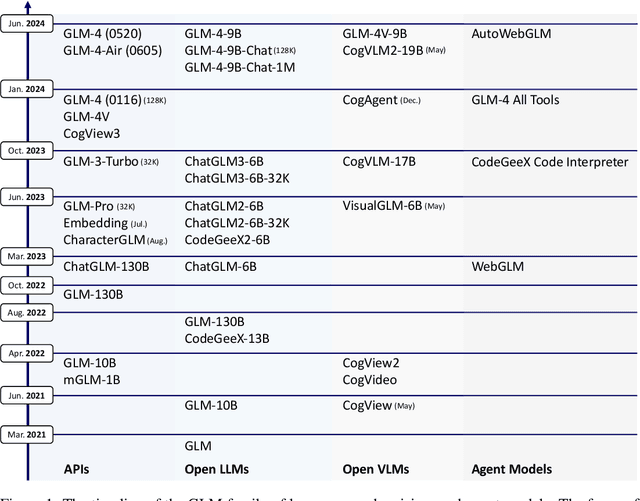
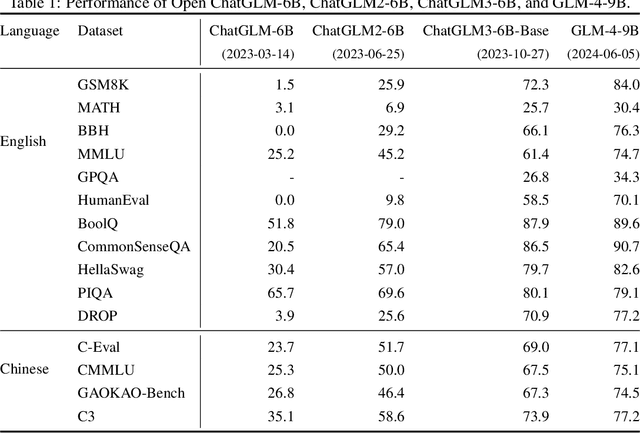
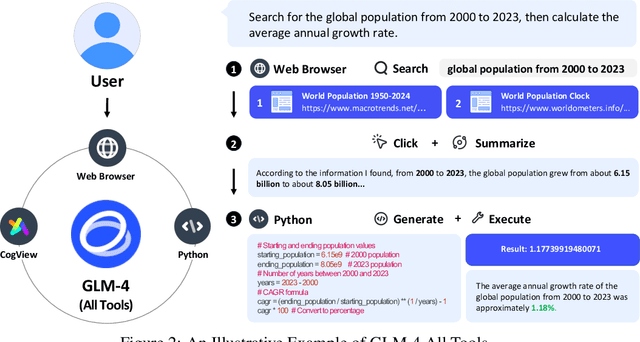
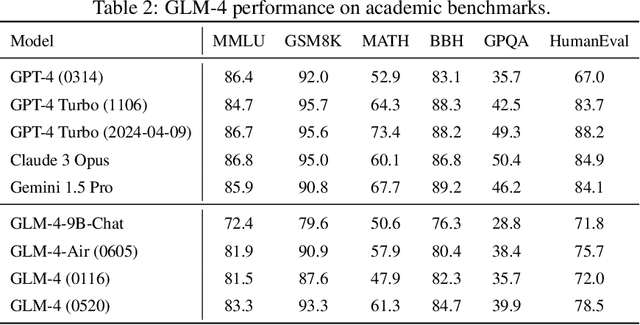
Abstract:We introduce ChatGLM, an evolving family of large language models that we have been developing over time. This report primarily focuses on the GLM-4 language series, which includes GLM-4, GLM-4-Air, and GLM-4-9B. They represent our most capable models that are trained with all the insights and lessons gained from the preceding three generations of ChatGLM. To date, the GLM-4 models are pre-trained on ten trillions of tokens mostly in Chinese and English, along with a small set of corpus from 24 languages, and aligned primarily for Chinese and English usage. The high-quality alignment is achieved via a multi-stage post-training process, which involves supervised fine-tuning and learning from human feedback. Evaluations show that GLM-4 1) closely rivals or outperforms GPT-4 in terms of general metrics such as MMLU, GSM8K, MATH, BBH, GPQA, and HumanEval, 2) gets close to GPT-4-Turbo in instruction following as measured by IFEval, 3) matches GPT-4 Turbo (128K) and Claude 3 for long context tasks, and 4) outperforms GPT-4 in Chinese alignments as measured by AlignBench. The GLM-4 All Tools model is further aligned to understand user intent and autonomously decide when and which tool(s) touse -- including web browser, Python interpreter, text-to-image model, and user-defined functions -- to effectively complete complex tasks. In practical applications, it matches and even surpasses GPT-4 All Tools in tasks like accessing online information via web browsing and solving math problems using Python interpreter. Over the course, we have open-sourced a series of models, including ChatGLM-6B (three generations), GLM-4-9B (128K, 1M), GLM-4V-9B, WebGLM, and CodeGeeX, attracting over 10 million downloads on Hugging face in the year 2023 alone. The open models can be accessed through https://github.com/THUDM and https://huggingface.co/THUDM.
DICE: Detecting In-distribution Contamination in LLM's Fine-tuning Phase for Math Reasoning
Jun 06, 2024Abstract:The advancement of large language models (LLMs) relies on evaluation using public benchmarks, but data contamination can lead to overestimated performance. Previous researches focus on detecting contamination by determining whether the model has seen the exact same data during training. In this work, we argue that even training on data similar to benchmark data inflates performance on in-distribution tasks without improving overall capacity, which we called In-distribution contamination. To effectively detect in-distribution contamination, we propose DICE, a novel method that leverages the internal states of LLMs to locate-then-detect the contamination. DICE first identifies the most sensitive layer to contamination, then trains a classifier based on the internal states of that layer. Experiments reveal DICE's high accuracy in detecting in-distribution contamination across various LLMs and math reasoning datasets. We also show the generalization capability of the trained DICE detector, which is able to detect contamination across multiple benchmarks with similar distributions. Additionally, we find that the DICE detection scores are positively correlated with the performance of ten LLMs fine-tuned by either us or other organizations on four math reasoning datasets (with $R^2$ values between 0.6 and 0.75). This indicates that the in-distribution contamination problem potentially lead to an overestimation of the true capabilities of many existing models. The code and data are available at https://github.com/THU-KEG/DICE.
 Add to Chrome
Add to Chrome Add to Firefox
Add to Firefox Add to Edge
Add to Edge